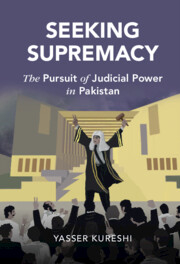Book contents
- Seeking Supremacy
- Cambridge Studies in Law and Society
- Seeking Supremacy
- Copyright page
- Dedication
- Contents
- Figures
- Tables
- Acknowledgements
- Introduction
- Chapter One The Judiciary, Rule of Law and the Military
- Chapter Two The Loyal Court (1947–1977)
- Chapter Three The Controlled Court (1977–1999, Part 1)
- Chapter Four Between the Barracks and the Bar (1977–1999, Part 2)
- Chapter Five The Confrontational Court (1999–2017)
- Chapter Six Epilogue
- Chapter Seven Conclusion and Comparative Perspectives
- Appendix: Structure of the Pakistani Judiciary
- References
- Index
- Cambridge Studies in Law and Society
Chapter Five - The Confrontational Court (1999–2017)
The Judiciary Challenges Military and Civilian Power
Published online by Cambridge University Press: 08 September 2022
- Seeking Supremacy
- Cambridge Studies in Law and Society
- Seeking Supremacy
- Copyright page
- Dedication
- Contents
- Figures
- Tables
- Acknowledgements
- Introduction
- Chapter One The Judiciary, Rule of Law and the Military
- Chapter Two The Loyal Court (1947–1977)
- Chapter Three The Controlled Court (1977–1999, Part 1)
- Chapter Four Between the Barracks and the Bar (1977–1999, Part 2)
- Chapter Five The Confrontational Court (1999–2017)
- Chapter Six Epilogue
- Chapter Seven Conclusion and Comparative Perspectives
- Appendix: Structure of the Pakistani Judiciary
- References
- Index
- Cambridge Studies in Law and Society
Summary
In this chapter I describe and explain the judiciary’s increasing assertiveness towards military and civilian branches of government between 1999 and 2017. The chapter is divided into two sections. The first section discusses the trajectory of judicial–military relations during this period. It is divided into three phases: (1) 1999 to 2005, the early years of Musharraf’s rule when the judiciary remained cautious; (2) 2005 to 2008, when the judiciary and military clashed, leading to the fall of the military regime; and (3) 2008 to 2017, the period of constitutional democratic rule. In each period, I discuss the prevailing political situation, and the judiciary’s relationship with the military as demonstrated through its jurisprudence. Through this period, I show that the judiciary adopted a more assertive approach towards the military, beginning with contesting the military’s economic prerogatives, and gradually shifting to challenging the military’s political agenda and undermining the foundations of the regime, before seeking to take its place alongside the military as the overseer of Pakistan’s democratic political order.
- Type
- Chapter
- Information
- Seeking SupremacyThe Pursuit of Judicial Power in Pakistan, pp. 153 - 219Publisher: Cambridge University PressPrint publication year: 2022
- 1
- Cited by

